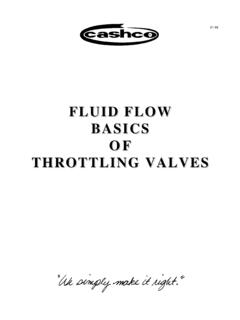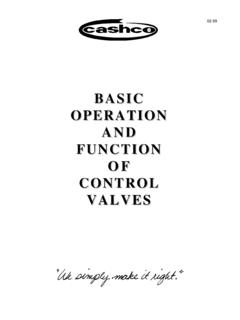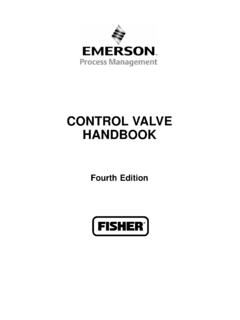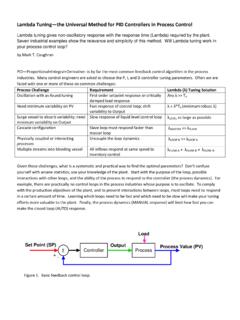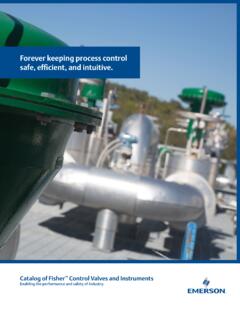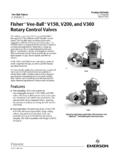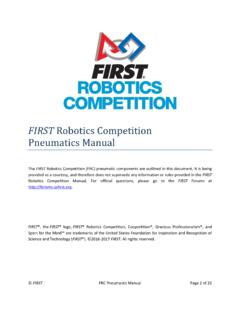Transcription of FLUID FLOW BASICS OF THROTTLING VALVES
1 FLUID FLOWFLUID FLOWBASICSBASICSOFOFTHROTTLING VALVESTHROTTLING hrottlingValveUpstreamDownstreamFLUID FLOW BASICS OF THROTTLING VALVESFLUID PARAMETERS FLUID PARAMETERS The following FLUID parameters are frequently associated with THROTTLING VALVES PSize = P1 - P2 T = T1 - T2 PressuresFlowQuantityThermo-dynamicRelat iveWeight/MassGeometricFluid Resistanceto Flow CONDITION 1 CONDITION 2m1_____Mass Flow Rate _____ m2Q1, 1_____Volumetric Flow Rate _____ Q2, 2P1, PS1, P1(Abs)_____Static Pressure _____ P2, PS2, P2 (Abs)PV1_____Velocity Pressure _____ PV2 PVC Pressure @ Vena Contracta Psize Sizing Pressure DropVapor PressurePVP1, PSAT1 PVP2, PSAT2 Saturation PressureT1, 1(Abs), T1@xx SH_____Temperature _____ T2, 2(Abs), T 2@xx SHTSAT1_____Saturation Temperature _____ TSAT2H1, h1_____Enthalpy _____ H2, h2 1_____Specific Volume _____ 2 1_____Liquid Density _____ 2 1_____Actual Gas Density_____ 2SG1_____Specific Gravity _____ SG2 1P_____Pipe Diameter _____ 2P 1V_____Valve Body Size _____ 2VZ1_____Elevation Head _____ Z2A1_____Cross-Section Area _____ A2v1V_____Avg.
2 Valve Velocity _____ v2Vv1P_____Avg. Pipe Velocity _____ v2P 1_____Absolute Viscosity _____ 2 1_____Kinematic Viscosity _____ hrottlingValve P = P - P12 UpstreamDownstreamTHE BASICS OF THROTTLING VALVESTHROTTLING VALVESTHROTTLING VALVESV alves that are utilized as FLUID control devices are typically THROTTLING VALVES .Such VALVES experience internal velocity and internal pressure gradients (both positive andnegative) that conclude with a permanent pressure loss ( P) from the inlet pipe-to-outlet pipeconnections. THROTTLING valve trim (plug-seat) experiences relatively high internal velocitiesnearly 100% of operating time.
3 In comparison, ON-OFF automated or manual VALVES experi-ence velocity changes ONLY when being actuated from open-to-closed , or vice versa; afew seconds or s Theorem is the most useful tool inanalyzing what is going on physically withinthe walls of a THROTTLING valve, which includes velocity gradients pressure gradientsThe other important tool is the 1st Law ofThermodynamics which allows analyzing FLUID state thermal effectsBernoulli s principles apply to the following forthrottling VALVES inlet pipe reducer pressure drop to main orifice pressure recovery to outlet outlet pipe reducer-4-When the pressure gradients are graphically shown.
4 One ends up with the rather typical venacontracta curve The velocity gradients form a sort of inverse of the vena contracta curve -5-The depth of the vena contracta dip is primarily a function of a THROTTLING valve s geometry;globe vs. butterfly, etc. The important parameter in determining the PVC is FL LiquidPressure Recovery Factor . As the name implies, the FL factor is a measure of the effective-ness of the reconversion of velocity pressure into static pressure from the main orifice of thethrottling valve (@ vena contracta) to the valve s following graphic attempts to give relative representation of the four major valve stylesused for THROTTLING butterfly and ball VALVES are sub-classified as high recovery VALVES .
5 As a general rule,globe and eccentric plug (rotary globe) styles tend to make better THROTTLING control hrottlingValveUpstreamDownstreamLIQUID(N on-Compressible)GAS VAPOR(Compressible) P = P1 - P2 LIQUIDLIQUIDFLUID STATESFLUID STATESF luid flow is classified into two basic FLUID states at the pressure changes occur within a THROTTLING valve, it is possible to produce 2-phase flow atthe valve s outlet for either a liquid or gas-vapor at the vapor is a gas that is at, or relatively near, its saturation (boiling) conditions of pressureand temperature; saturated vapor or slightly superheated vapor. A gas is a FLUID that doesnot liquify at reduced temperatures, or is a highly superheated VALVES operate as steady state, steady flow devices.
6 The entering and exiting massflow rates are the same; flow is continuous , and the Continuity Equation is applicable It is a thermodynamic principle that whenever there is a phase change between a throttlingvalve s entering and exiting FLUID state, there is also a temperature change ( decrease orcooling) in all such applications T1 > T2 LIQUIDS. For simple liquid-in and liquid-out flow there is no density change of the liquid 1 = 2 This constant density results in other parameters being typically affected ..m1 = m2(EQ. #1)1A1v1 = 2A2v2(no phase change)1A1v1 = 2VA2Vv2V + 2LA2Lv2L(2-phase outlet)VaporLiquidm1 = m2A1 = A2T1 = T2 no phase changev1 = v2 1 = 21 = hrottlingValveUpstreamDownstreamGAS-VAPO RS.
7 For simple gas-vapor-in and gas-vapor-out flow, there is a density change( decrease) of the gas-vapor as the FLUID decompresses ( expands) 1 > 2 This changing density results in other parameters being typically affected GAS-VAPORGAS-VAPOR h = h1 - h2 h = 0 THERMODYNAMIC PRINCIPLESTHERMODYNAMIC PRINCIPLESTHROTTLING PROCESS. In looking into the thermodynamic principles of a THROTTLING pro-cess , we know hrottlingValve P = P - UnitsMetric Unitsh1= Valve Inlet EnthalpyBtu/#kJ/kgh2= Valve Outlet EnthalpyBtu/#kJ/kgm1= Inlet Mass Flow#/Hrkg/Hrm2= Outlet Mass Flow#/HrKg/HrTHE CHANGE IN ENTHALPY ACROSS A RESTRICTION IN A PIPE ORIFICE, REGULA-TOR, CONTROL VALVE IS ZERO FOR A THROTTLING the continuity equation m1 = m2m1h1 m2h2 = 0 OR(EQ.)
8 #2)m(h1 h2) = = m2A1 < A2T1 T2 GAS or HIGHLYSUPERHEATED VAPORv1 > v2 1 < 2T1 > T2 VAPOR1 > 2-8-It is the use of FLUID thermodynamic data and the thermodynamic principles of the constantenthalpy THROTTLING process that THROTTLING VALVES experience which allows an accurate determi-nation of a FLUID s state while internal to the valve as well as at the valve s outlet. In particular,we want to know what the FLUID is physically doing at the THROTTLING valve s main orifice (plug-seat); what is occurring at the vena contracta and elsewhere within the valve?SATURATION STATE. A FLUID is said to be saturated when Liquid - when at the boiling temperature Tsat for a given pressure PsatExamples: Water @ Psat = psia Tsat = 212 FPsat = BarA Tsat = 100 CWater @Psat = 145 psig Tsat = FPsat = 10 BarA Tsat = C Vapor - when at the boiling temperature Tsat for a given pressure PsatExamples: Steam @ Psat = psia Tsat = 212 FPsat = BarA Tsat = 100 CSteam @ Psat = 145 psig Tsat = FPsat = 10 BarA Tsat = CRestating the above examples, we have both saturated liquid water (condensate) and satu-rated steam at the same Psat and Tsat.
9 Further, for any given FLUID in its saturation state, whenwe have its pressure (Psat), we KNOW its temperature (Tsat). To say a FLUID is saturated is togive a property of the FLUID . Only two extensive properties of a FLUID will locate the FLUID in thephysical universe. We know exactly where a FLUID is when we say the FLUID is saturated water at Psat = 29 psia = BarA, we know that Tsat = F = C. saturated steam at Tsat = 212 F = 100 C, we know that Psat = psig = VAPOR. A FLUID is a superheated vapor when its temperature is greater thanTsat corresponding to the flowing : Steam @ P1 = 145 psia & T1 = 425 F SH(Tsat = F)P1 = 10 BarA & T1 = 219 C SH(Tsat = C)-9-To say a vapor is superheated does NOT give an extensive property of the FLUID ; so, a secondproperty must also be known to physically locate a superheated vapor in the LIQUID.
10 A liquid is sub-cooled when its temperature is less than Tsat corre-sponding to the flowing : Water @P = 145 psia & T = 60 F(Tsat = F)P = 10 BarA & T = C(Tsat = C)To say a liquid is sub-cooled is NOT to give an extensive property of the FLUID ; so, a secondproperty must also be known to physically locate a sub-cooled liquid in the CURVE T vs. H GRAPH. The following graph is plotted using thermodynamic datafor steam condensate; straight out of the Steam Tables .These graphs are NOT useful for sub-cooled liquids; they are ONLY useful for analyzing boil-ing (vaporizing) liquid/vapors and superheated critical properties of Critical Pressure - Pc and Critical Temperature - Tc are located atthe peak of the T vs.

